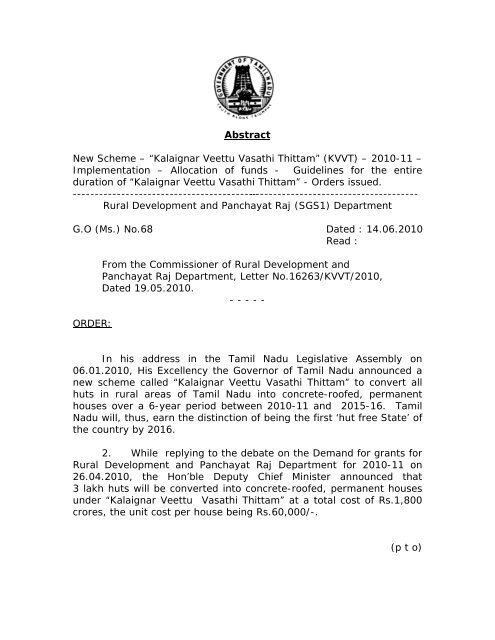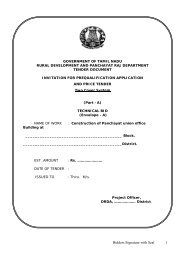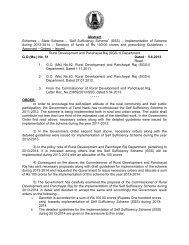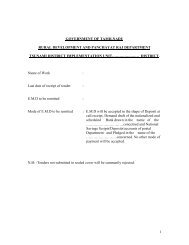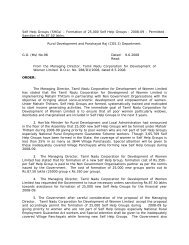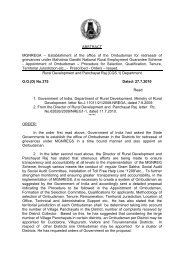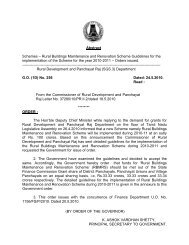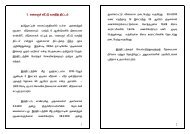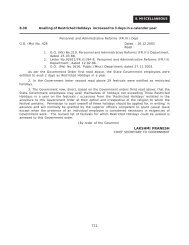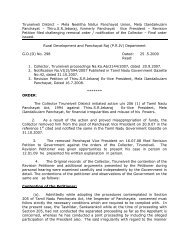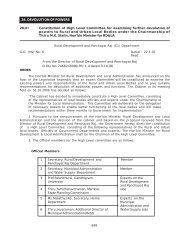RD & PR (SGS1) Dept - Tnrd.gov.in
RD & PR (SGS1) Dept - Tnrd.gov.in
RD & PR (SGS1) Dept - Tnrd.gov.in
Create successful ePaper yourself
Turn your PDF publications into a flip-book with our unique Google optimized e-Paper software.
3(iv)The Director of Rural Development and Panchayat Raj isauthorised to draw the annual allocation for “KalaignarVeettu Vasathi Thittam” <strong>in</strong> four quarterly <strong>in</strong>stalmentsand disburse the same to the Districts as follows :-(a)The first quarterly <strong>in</strong>stalment of eachf<strong>in</strong>ancial year equal to one-fourth of theBudget provision for “Kalaignar VeettuVasathi Thittam” shall be drawn by theDirector of Rural Development andPanchayat Raj automatically.(b) The 2 nd , 3 rd and 4 th quarterly <strong>in</strong>stalmentscan be drawn by the Director of RuralDevelopment and Panchayat Raj only aftergett<strong>in</strong>g clearance from an EmpoweredCommittee compris<strong>in</strong>g the Pr<strong>in</strong>cipalSecretary to Government, F<strong>in</strong>anceDepartment, Pr<strong>in</strong>cipal Secretary toGovernment, Rural Development andPanchayat Raj Department and theDirector of Rural Development andPanchayat Raj, who shall be its convenor.5. The expenditure sanctioned at para 4 (ii) above shall bedebitable under the follow<strong>in</strong>g head of account:(i) 4216 – Capital Outlay on Hous<strong>in</strong>g –03 – Rural Hous<strong>in</strong>g 789 - SpecialComponent Plan for Scheduled CastesSchemes <strong>in</strong> the Eleventh Five Year Plan IIState Plan JA – Kalaignar Hous<strong>in</strong>g Schemeunder Special Component Plan.(Rs. <strong>in</strong> crores)16. Major works (DPC No.4216-03-789-JA-1607) – Rs.780.00(ii) 4216 – Capital outlay on Hous<strong>in</strong>g –03 – Rural Hous<strong>in</strong>g 796 - Tribal AreaSub-Plan – Schemes <strong>in</strong> the Eleventh FiveYear Plan – II State Plan. JA- KalaignarHous<strong>in</strong>g Scheme under Tribal AreaSub-Plan.16. Major works (DPC No.4216-03-796-JA-1602) - Rs. 20.00
(iii) 4216 – Capital outlay on Hous<strong>in</strong>g 03 –Rural Hous<strong>in</strong>g 800 - Other Expenditure –Schemes <strong>in</strong> the Eleventh Five Year Plan –II State Plan JA - Kalaignar Hous<strong>in</strong>gScheme.416. Major works (DPC No.4216-03-800-JA-1601) - Rs.1000.00--------------------TotalRs.1800.00 crores6. This order issues with the concurrence of F<strong>in</strong>anceDepartment vide its U.O.No.109/DS (B)/2010, Dated 10.06.2010.---------------------(By Order of the Governor)K.ASHOK VA<strong>RD</strong>HAN SHETTY,Pr<strong>in</strong>cipal Secretary o GovernmentToThe Director of Rural Development and Panchayat Raj, Chennai- 15.All District Collectors.All Project Directors, District Rural Development Agencies.All District Panchayats.All Block Development Officers(through Director of Rural Development and Panchayat Raj)Pay and Accounts Officer (South), Chennai – 35.Rural Development & Panchayat Raj (<strong>PR</strong>1) Department, Chennai – 9.Copy to:The Secretary to Hon’ble Chief M<strong>in</strong>ister, Chennai – 9.The Senior Personal Assistant to Hon’ble F<strong>in</strong>ance M<strong>in</strong>ister, Chennai – 9.The Senior Personal Assistant to Hon’ble Deputy Chief M<strong>in</strong>ister,Chennai – 9.The F<strong>in</strong>ance (<strong>RD</strong>) Department, Chennai – 9.//Forwarded By Order//Section Officer
5G.O.(Ms.) No.68, <strong>RD</strong> & <strong>PR</strong> (<strong>SGS1</strong>) Department, dated14.06.2010ANNEXUREGuidel<strong>in</strong>es of Kalaignar Veettu Vasathi Thittam (KVVT)1. Introduction:As per the 2001 Census, the percentage of households liv<strong>in</strong>g <strong>in</strong>temporary houses (i.e. houses with both walls and roofs made oftemporary materials) is 23% for Tamil Nadu, which is greater than theAll India percentage (18%). In Tamil Nadu, the problem of temporaryhouses is very high <strong>in</strong> rural areas (about 1/3 rd ) as compared to urbanareas (about 1/10 th ). Over the past 25 years, a number of permanenthouses have been built under the Centrally-sponsored Indira AwaasYojana (IAY). However, it is estimated that if all the huts <strong>in</strong> rural areasare to be converted to permanent houses only under IAY, it will takeanother 30 years to clear the backlog. Hence, this Government hasdesigned a fully State Government-funded, mega Scheme to convertall the huts <strong>in</strong> rural areas <strong>in</strong>to concrete roofed, permanent houseswhich will be given free of cost to the beneficiaries.‘Kalaignar Veettu Vasathi Thittam’ (KVVT) was announced bythe Government of Tamil Nadu dur<strong>in</strong>g the Governor’s Address <strong>in</strong> TamilNadu Legislative Assembly on 6.1.2010. The Scheme aims at replac<strong>in</strong>gall the huts <strong>in</strong> rural Tamil Nadu with permanent houses over a 6-yearperiod between 2010-11 and 2015-16. Tamil Nadu will, thus, earn thedist<strong>in</strong>ction of be<strong>in</strong>g the first ‘hut free State’ of the country by 2016.2. Salient features of the Scheme:(i)All huts with thatched roof irrespective of the type of wall of thehuts, will be taken up for conversion <strong>in</strong>to permanent housesunder KVVT over the six year period.
6(ii)(iii)The permanent houses will be constructed <strong>in</strong> situ and no landacquisition is envisaged under the Scheme. Only people withpattas for their houses sites will be eligible; huts constructed onporamboke lands will not be replaced with permanent housesunder KVVT unless the porambokes are of an unobjectionablenature and the encroachments can be regularised by Revenueauthorities.The follow<strong>in</strong>g types of huts will not be eligible for be<strong>in</strong>gconverted <strong>in</strong>to permanent houses under KVVT –• Huts occupied by tenants.• Huts used for commercial purposes or for animals.• Huts that have part thatched roof and partRCC/Tiled/AC sheet/metal sheet roof.• Huts that have thatch put over RCC/Tiled/ACsheet/metal sheet roof.• Huts whose occupants also own a pucca houseelsewhere.• Huts, if any, owned by retired or serv<strong>in</strong>g Governmentservants (full-time, part-time, contract appo<strong>in</strong>tment, dailywage appo<strong>in</strong>tment) <strong>in</strong>clud<strong>in</strong>g employees of Local Bodies,PSUs, Government Aided Institutions, Boards and otherquasi-<strong>gov</strong>ernment undertak<strong>in</strong>gs or their spouses.• Huts, if any, owned by sitt<strong>in</strong>g MPs, MLAs and LocalBody functionaries or their spouses.• Huts, if any, built after 1.1.2010.(iv) Enumeration and Super check:It is necessary to freeze the list of beneficiaries <strong>in</strong> the beg<strong>in</strong>n<strong>in</strong>gitself <strong>in</strong> order to guard aga<strong>in</strong>st the possibility of some persons putt<strong>in</strong>gup ‘new thatched roof houses’ to corner multiple benefits. Hence, it
7was decided to undertake the enumeration of all huts <strong>in</strong> all the VillagePanchayats <strong>in</strong> the State to make a quick assessment of the number ofhuts to be replaced by permanent houses under KVVT.In the first phase, a Pilot Survey was conducted dur<strong>in</strong>g February,2010 <strong>in</strong> select Village Panchayats at the rate of 1 Village Panchayat perBlock <strong>in</strong> all Districts of the State.Based on the lessons learnt from the Pilot Survey and thedecisions taken at the meet<strong>in</strong>gs conducted by the Chief Secretary on26.1.2010, and by the Honourable Chief M<strong>in</strong>ister on 4.3.2010, certa<strong>in</strong>modifications were made <strong>in</strong> the Enumeration Format and thereafter,detailed <strong>in</strong>structions were given regard<strong>in</strong>g enumeration of huts, supercheckof such enumeration, verification of Enumeration Registers bythe Master Tra<strong>in</strong>ers, data entry <strong>in</strong> the Web-based KVVT software,generation of verification-cum-application form, tak<strong>in</strong>g of photographsthrough second-round of field visits, and fil<strong>in</strong>g of records videAnnexures I, II and III as detailed below. (The enumeration of hutswas commenced on 29.3.2010 <strong>in</strong> all Districts except Dharmapuri,where the enumeration was commenced on 12.4.2010):-
8Annexure-I: D.O. letter No.1719/SGS-1/2010 dated 8.3.2010,D.O. letter No.1719/SGS-1/2010 dated 9.3.2010andD.O. letter No.1719/SGS-1/2010 dated 22.4.2010 ofPr<strong>in</strong>cipal Secretary to Government, <strong>RD</strong>&P<strong>RD</strong>epartment, Chennai-9 addressed to all DistrictCollectors.Annexure-II: Format for Enumeration of huts with thatchedroof along with the Abstracts.Annexure-III: Instructions to Enumerators for the survey ofhuts for KVVT Scheme and Instructions to Supercheck<strong>in</strong>gofficials for the survey of huts.The above <strong>in</strong>structions and guidel<strong>in</strong>es are ratified byGovernment.The list of eligible beneficiaries <strong>in</strong> each Village Panchayat shall beplaced before the Grama Sabha for <strong>in</strong>formation. Instructions regard<strong>in</strong>gdisposal of grievance petitions, if any, about huts wrongly excludedfrom, or wrongly <strong>in</strong>cluded <strong>in</strong> the list of eligible huts, shall be separatelyissued by the Director of Rural Development and Panchayat Raj.3. Allocation of permanent houses to Village Panchayats:(i) The Scheme will be implemented <strong>in</strong> all the Village Panchayats <strong>in</strong>the State where enumeration of huts has been undertaken. The annualallocation of KVVT houses to each Village Panchayat <strong>in</strong> the State willconsist of two components:(a) a fixed component, which will be decided by the Director of RuralDevelopment and Panchayat Raj <strong>in</strong> consultation with the Pr<strong>in</strong>cipalSecretary, <strong>RD</strong>& <strong>PR</strong> Department, and (b) a variable component which isthe share of each Village Panchayat when the rema<strong>in</strong><strong>in</strong>g houses are
9apportioned among all Village Panchayats <strong>in</strong> proportion to the numberof eligible huts <strong>in</strong> each of them.(ii) The number of habitations <strong>in</strong> a Village Panchayat varies from 1to over 100 across the State, with an average of 8 habitations perVillage Panchayat. Tak<strong>in</strong>g up construction of permanent houses <strong>in</strong> allthe habitations simultaneously will not be desirable as (a) the numberof permanent houses will be spread very th<strong>in</strong>ly and the impact of theScheme will be m<strong>in</strong>imal, and (b) the implementation and monitor<strong>in</strong>g ofthe Scheme <strong>in</strong> all the habitations (about 90,000 plus) simultaneouslywill be extremely difficult. Another option is to arrange the habitationswith<strong>in</strong> each Village Panchayat <strong>in</strong> the descend<strong>in</strong>g order of the totalnumber of eligible huts <strong>in</strong> each habitation, and take up construction ofpermanent houses only <strong>in</strong> a few habitations each year, start<strong>in</strong>g fromthe habitation with the maximum number of eligible huts. This optionmay also create difficulties because many habitations <strong>in</strong> Tamil Nadutend to be (predom<strong>in</strong>antly) s<strong>in</strong>gle-Community habitations, and equityacross Communities may not be ma<strong>in</strong>ta<strong>in</strong>ed at least <strong>in</strong> the <strong>in</strong>itial yearslead<strong>in</strong>g to criticism. In order to overcome these difficulties, thefollow<strong>in</strong>g method of sub-allocation of each Village Panchayat’sallocation is proposed.4. Sub-allocation of permanent houses among variousCommunities and habitations with<strong>in</strong> a Village Panchayat:(i) Sub-allocation among Communities: With a view to ensur<strong>in</strong>gequity across Communities, the allocation of permanent houses underKVVT for each Village Panchayat will be sub-allocated among variousCommunities (ST, SC, MBC, BC and OC) <strong>in</strong> proportion to the totalnumber of eligible huts belong<strong>in</strong>g to members of each Community <strong>in</strong>
10the Village Panchayat as per the enumeration. [This is a majordifference between KVVT and IAY].Illustration 1: A Village Panchayat has 4 Habitations - A, B, C and D.The total number of eligible huts <strong>in</strong> the Village Panchayat is 900, whoseCommunity-wise distribution is as follows - SC – 300, MBC – 250, BC – 300,and OC – 50.If the total allocation of permanent houses to this Village Panchayat underKVVT for 2010-11 is 150, then these 150 houses should be apportionedamongst various Communities <strong>in</strong> the ratio of 300:250:300:50. Therefore, theCommunity-wise allocation <strong>in</strong> the Village Panchayat will be as under –o SC allocation =HousesNumber of eligible SC huts x Allocation of PermanentTotal No. of eligible huts <strong>in</strong> V.Pt= 300 x 150 =50900o MBC allocation= Number of eligible MBC huts x Allocation of PermanentHousesTotal No. of eligible huts <strong>in</strong> V.Pto BC allocation =Houseso OC allocation =Houses= 250 x 150 = 41.66, or 42900Number of eligible BC huts x Allocation of PermanentTotal No. of eligible huts <strong>in</strong> V.Pt= 300 x 150 =50900Number of eligible OC huts x Allocation of PermanentTotal No. of eligible huts <strong>in</strong> V.Pt= 50 x 150 =8.33, or 8900(ii) F<strong>in</strong>alis<strong>in</strong>g the ‘priority list of habitations with<strong>in</strong> each VillagePanchayat for each Community’: The hut-dwellers belong<strong>in</strong>g todifferent Communities (ST, SC, MBC, BC and OC) may be spread
11across one or more habitations with<strong>in</strong> each Village Panchayat. For eachCommunity, a 'priority list' shall be prepared by arrang<strong>in</strong>g thehabitations <strong>in</strong> the descend<strong>in</strong>g order of the number of eligible hutsbelong<strong>in</strong>g to that Community - based on the 2010 enumerationresults. In the <strong>in</strong>terests of greater clarity, transparency and certa<strong>in</strong>tythis ‘priority list of habitations with<strong>in</strong> each Village Panchayat for eachCommunity’ will be frozen for the entire duration of the Scheme,notwithstand<strong>in</strong>g the fact that it may get altered <strong>in</strong> a few cases <strong>in</strong> thecourse of six years whenever the ‘conditionally eligible’ cases become‘eligible’ cases (e.g. as when encroachments on unobjectionableporambokes are regularised and given pattas).N.B. ‘Conditionally eligible’ cases which become ‘eligible’ cases <strong>in</strong> agiven f<strong>in</strong>ancial year will become entitled to permanent houses underKVVT from the next f<strong>in</strong>ancial year onwards (subject to the otherconditions laid down <strong>in</strong> these guidel<strong>in</strong>es), but they will not alter the‘priority list of habitations with<strong>in</strong> each Village Panchayat for eachCommunity’ which will be frozen as <strong>in</strong> 2010-11 for the entire durationof the Scheme.(iii) Mode of sub-allocation of permanent houses amongHabitations for each Community: After the ‘priority list' ofhabitations with<strong>in</strong> each Village Panchayat for each Community’ isfixed, the permanent houses under KVVT for a particularCommunity will be sub-allocated to the first habitation <strong>in</strong> the'priority list', i.e. the habitation with the maximum number ofeligible huts of that Community. In case the sub-allocation of thehouses for a particular Community <strong>in</strong> the first habitation is greaterthan the number of eligible huts of that Community, then thebalance number of permanent houses will be sub-allocated to the
12second habitation <strong>in</strong> the 'priority list', i.e. the habitation with thenext highest number of eligible huts for that Community, and so on.In the next f<strong>in</strong>ancial year, the houses for the particular Community willbe first sub-allocated to that habitation which has been only partiallycovered <strong>in</strong> the previous year, and then sub-allocated as per the'priority list' . This process will be repeated year after year till all theeligible huts <strong>in</strong> the Village Panchayat have been taken up forconversion <strong>in</strong>to permanent houses.Illustration 2: In the Village Panchayat referred to <strong>in</strong> Illustration 1 above,the total number of eligible huts is 900. The Community-wise and Habitationwisedistribution of the eligible huts is given <strong>in</strong> Table 1:Table 1Number of Eligible Huts <strong>in</strong> each Habitation :2010-11Community HabitationAHabitationBHabitationCHabitationDTotalnumberfor theVillagePanchayatSC 150 125 - 25 300MBC - 150 50 50 250BC 55 75 80 90 300OC- - - 50 50Total for allcommunities 205 350 130 215 900As expla<strong>in</strong>ed <strong>in</strong> Illustration 1 above, if the allotment of permanenthouses for 2010-11 is 150, the Community-wise break-up is: SC-50, MBC-42, BC-50, and OC-8.‣ The priority list of habitations for SCs will be 'A' followed by 'B'and 'D'. The 50 SC houses will be allotted dur<strong>in</strong>g 2010-11 toHabitation ‘A’ as it is first <strong>in</strong> the priority list with the maximumnumber of eligible huts.
13‣ The priority list of habitations for MBCs will be 'B' followed byboth 'C' and 'D' (which are jo<strong>in</strong>t second). Hence, the 42 MBChouses will be allotted dur<strong>in</strong>g 2010-11 to Habitation ‘B’.‣ The priority list of BC huts will be 'D' followed by 'C', 'B' and 'A'.Hence, the 50 BC houses will be allotted dur<strong>in</strong>g 2010-11 toHabitation ‘D’.‣ All the 50 huts belong<strong>in</strong>g to OCs are located <strong>in</strong> Habitation ‘D’. Hence,the 8 OC houses will be allotted to Habitation ‘D’.Thus, after the allotment of 150 permanent houses Community-wiseand Habitation-wise <strong>in</strong> 2010-11, the distribution of the eligible huts <strong>in</strong> theVillage Panchayat at the beg<strong>in</strong>n<strong>in</strong>g of the next f<strong>in</strong>ancial year, i.e. 2011-12will be as shown <strong>in</strong> Table 2:Table 2Number of Eligible Huts <strong>in</strong> each Habitation: 2011-12CommunityHabitationAHabitationBHabitationCHabitationDTotalnumberfor theVillagePanchayatSC 150-50=100 125 0 25300-50=250MBCBC0150-42=108 50 5090 - 5055 75 80=40250-42=208300-50=250OC50-8=4250-8=420 0 0Total for allcommunities 155 308 130 157 750Assum<strong>in</strong>g that the allocation of permanent houses under KVVT dur<strong>in</strong>g 2011-12 is aga<strong>in</strong> 150, the Community-wise break-up is aga<strong>in</strong>: SC-50, MBC-42, BC-50, and OC-8.
14Dur<strong>in</strong>g 2011-12, the houses for the particular Community will befirst sub-allocated to that habitation which has been only partiallycovered <strong>in</strong> 2010-11, and the rema<strong>in</strong><strong>in</strong>g houses, if any, will be suballocatedaccord<strong>in</strong>g to the priority list of habitations.‣ In respect of SCs, Habitation ‘A’ which was first <strong>in</strong> the priority listwas only partially covered dur<strong>in</strong>g 2010-11. Hence, the 50 SChouses will be allotted aga<strong>in</strong> to Habitation ‘A’ dur<strong>in</strong>g 2011-12.‣ In respect of MBCs, Habitation ‘B’ was only partially covereddur<strong>in</strong>g 2010-11. Hence, the 42 MBC houses will be allotted aga<strong>in</strong> toHabitation ‘B’ dur<strong>in</strong>g 2011-12.‣ In respect of BCs, Habitation ‘D’ was only partially covered dur<strong>in</strong>g2010-11. Hence, the 50 BC houses will be allotted dur<strong>in</strong>g 2011-12as follows: (a) 40 houses to Habitation ‘D’ cover<strong>in</strong>g it fully, and(b) the rema<strong>in</strong><strong>in</strong>g 10 houses to Habitation 'C' which is second <strong>in</strong>the priority list.‣ All the 42 huts belong<strong>in</strong>g to OCs are located only <strong>in</strong> Habitation ‘D’which was only partially covered dur<strong>in</strong>g 2010-11. Hence, the 8 OChouses will be allotted to Habitation ‘D’ dur<strong>in</strong>g 2011-12.The SC houses will be sub-allocated to Habitation ‘B’ (which is second<strong>in</strong> the priority list) <strong>in</strong> a future year only after Habitation ‘A’ has beenfully covered, and to Habitation ‘D’ only after Habitation ‘B’ has beenfully covered. Similarly, MBC houses will be sub-allocated equally toHabitations ‘C’ and ‘D’ (because they are jo<strong>in</strong>t-second <strong>in</strong> the prioritylist) <strong>in</strong> a future year only after Habitation ‘B’ has been fully covered.
155. Identification of Beneficiaries with<strong>in</strong> the selectedHabitations:(i) Hav<strong>in</strong>g determ<strong>in</strong>ed the sub-allocation of permanent houses amongthe various habitations for each Community as expla<strong>in</strong>ed <strong>in</strong> para 4, thenext step is to select the <strong>in</strong>dividual beneficiaries from among theeligible cases. Under KVVT, the beneficiaries shall be identified by amethod which is fair, transparent and automatic, and which is easily<strong>in</strong>telligible to all concerned.(ii) With this end <strong>in</strong> view, the follow<strong>in</strong>g procedure is prescribed:With<strong>in</strong> each habitation where the beneficiaries belong<strong>in</strong>g to aparticular Community have to be selected, they shall be chosen<strong>in</strong> the ascend<strong>in</strong>g order of New Door Numbers. The New Doornumbers as found <strong>in</strong> the May 2009 Electoral Rolls (which havebeen filled up <strong>in</strong> Column 5 of the Enumeration Register) shall beused for this purpose.Illustration 3: In Habitation ‘D’ of the Illustration 2 above, eligible hutsbelong<strong>in</strong>g to various communities have the New Door numbers as per theMay 2009 Electoral Roll (which have been entered <strong>in</strong> Col.5 of theEnumeration Register) as follows:• SCs - Door Nos. 51 to 75 (25 huts);• MBCs - Door Nos. 76 to 125 (50 huts);• BCs - Door Nos. 26 to 50, & Door Nos.151 to 215 (90 huts);• OCs - Door Nos. 1 to 25, & Door Nos. 126 to 150 (50 huts).In 2010-11, Habitation 'D' gets 50 houses for BCs and 8 houses for OCs.(Please see Table 1 and the notes below). The <strong>in</strong>dividual huts taken up forreplacement <strong>in</strong> Habitation ‘D’ <strong>in</strong> 2010-11 will be as follows -
16• BCs - Door Nos. 26 to 50 (25 houses), and Door No.151 to 175 (25houses) – i.e. 50 houses <strong>in</strong> all for BCs.• OCs – Door Nos. 1 to 8 – i.e. 8 houses;In 2011-12, Habitation 'D' gets 40 houses for BCs and 8 houses for OCs. The<strong>in</strong>dividual huts taken up for replacement <strong>in</strong> Habitation ‘D’ <strong>in</strong> 2011-12 will beas follows:• BCs - Door Nos. 176 to 215 – i.e. 40 houses.• OCs – Door Nos. 9 to 16 – i.e. 8 houses.The same methodology shall be followed for the other Habitations also.N.B: The Door Numbers <strong>in</strong> Illustration 3 have been shown to be cont<strong>in</strong>uousfor the sake of simplicity. But <strong>in</strong> actual practice, it is quite likely that the DoorNumbers of the eligible huts belong<strong>in</strong>g to a Community may not becont<strong>in</strong>uous s<strong>in</strong>ce (i) all the members of the Community may not be liv<strong>in</strong>g <strong>in</strong>houses with contiguous Door Numbers, (ii) even if they are liv<strong>in</strong>g <strong>in</strong> houseswith contiguous Door Numbers, not all of them may be huts, and (iii) even ifall of them are huts, not all of them may be eligible huts. Even if the NewDoor Numbers of the eligible huts of a Community with<strong>in</strong> a Habitation arediscont<strong>in</strong>uous, the pr<strong>in</strong>ciple for the identification of KVVT beneficiariesrema<strong>in</strong>s the same – <strong>in</strong> the ascend<strong>in</strong>g order of the New Door Numbers.(iii) The forego<strong>in</strong>g mode of selection of beneficiaries applies to ascenario where all the houses <strong>in</strong> a Habitation bear New Door Numbersrunn<strong>in</strong>g <strong>in</strong> a s<strong>in</strong>gle cont<strong>in</strong>uous sequence from 1 to the last, say, from 1to 215. It is possible that <strong>in</strong> some habitations, there may be multiplesequences of Door Numbers - with the Door Numbers start<strong>in</strong>g from 1(to the last Door No. <strong>in</strong> the street) for each street/locality with<strong>in</strong> theHabitation. For example, a Habitation may have 100 houses spreadacross 3 streets. Street 1 has 50 houses bear<strong>in</strong>g Door Nos. 1 to 50.Street 2 has 30 houses bear<strong>in</strong>g Door Nos. 1 to 30. Street 3 has 20
17houses bear<strong>in</strong>g (New) Door Nos. 1 to 20. In such a scenario, wheremultiple eligible huts belong<strong>in</strong>g to a particular Community may havethe same Door Numbers, the follow<strong>in</strong>g procedure for selection ofbeneficiaries under KVVT should be followed:1. Determ<strong>in</strong>e the street-wise distribution of eligible huts <strong>in</strong> theHabitation for the particular Community.2. Sub-allocate the permanent houses first to that street whichhas the highest number of eligible huts, and if there is anybalance left after cover<strong>in</strong>g all the eligible huts of the Community<strong>in</strong> the particular street, sub-allocate it next to that street whichhas the second highest number of eligible huts, and so on. [Inother words, where there are multiple series of Door Numbers(street-wise or locality-wise) with<strong>in</strong> a Habitation, the procedurefor sub-allocation of permanent houses among thestreets/localities with<strong>in</strong> the Habitation, is similar to that followedfor sub-allocation among Habitations with<strong>in</strong> a Village Panchayat.]3. Select beneficiaries <strong>in</strong> the ascend<strong>in</strong>g order of New DoorNumbers of eligible huts <strong>in</strong> the chosen street(s).4. In the next f<strong>in</strong>ancial year, the houses for the particularCommunity will be first sub-allocated to that street which wasonly partially covered <strong>in</strong> the previous year, and the rema<strong>in</strong><strong>in</strong>ghouses, if any, will be sub-allocated to the street with the nexthigher number of eligible huts of the particular Community. Thisprocess will be repeated year after year till all the eligible huts <strong>in</strong>the Village Panchayat have been taken up for conversion <strong>in</strong>topermanent houses.
18Illustration 4: A habitation, say ‘X’ has 100 eligible huts of SCs. The eligibleSC huts are distributed across 3 streets with Street 1 hav<strong>in</strong>g 50 huts, Street2 hav<strong>in</strong>g 30 huts, and Street 3 hav<strong>in</strong>g 20 huts.For 2010-11, the allocation of permanent houses under KVVT for SCs for thisHabitation is 30. These 30 houses will be sub-allocated entirely to Street 1which has the highest number of eligible huts (50). With<strong>in</strong> Street 1, the KVVTbeneficiaries will be selected <strong>in</strong> the ascend<strong>in</strong>g order of New Door Numbers.For 2011-12, if the allocation is aga<strong>in</strong> 30 houses, these will be sub-allocatedas follows: (a) 20 houses to Street 1 cover<strong>in</strong>g it fully, which was onlypartially covered <strong>in</strong> 2010-11and (b)10 houses to Street 2 which has thesecond highest number of eligible huts belong<strong>in</strong>g to SCs. With<strong>in</strong> Streets1 and 2, the KVVT beneficiaries will be selected <strong>in</strong> the ascend<strong>in</strong>g order ofNew Door Numbers.Illustration 5: A Habitation ‘Y’ has 80 eligible huts of MBCs. These aredistributed across 3 streets with Street 1 hav<strong>in</strong>g 30 huts, Street 2 hav<strong>in</strong>g 30huts, and Street 3 hav<strong>in</strong>g 20 huts.For 2010-11, the allocation of permanent houses under KVVT for MBCs forthis Habitation is 30. These 30 houses will be sub-allocated equally - 15 toStreet 1 and 15 to Street 2, as both have the jo<strong>in</strong>t highest number of huts(30). With<strong>in</strong> each street, the KVVT beneficiaries will be selected <strong>in</strong> theascend<strong>in</strong>g order of New Door Numbers <strong>in</strong> that street.For 2011-12, if the allocation is aga<strong>in</strong> 30 houses, these will be suballocatedat the rate of 15 houses each to Streets 1 and 2. With<strong>in</strong> eachstreet, the KVVT beneficiaries will be selected <strong>in</strong> the ascend<strong>in</strong>g order ofNew Door Numbers <strong>in</strong> that street.(iv) The Director of Rural Development and Panchayat Raj shalldevelop a Web-based Application software with the assistance ofNational Informatics Centre (NIC) authorities for the automaticallocation of permanent houses under KVVT among VillagePanchayats; sub-allocation among Communities, habitations andstreets; and identification of beneficiaries.
196. Type design and Unit Cost:Like IAY houses, KVVT houses will be built with RCC roof<strong>in</strong>g anda separate toilet. The area of a house shall be about 200 sq.ft. and theunit cost shall be Rs. 60,000 per house. Wherever possible, the toiletshall be constructed by dovetail<strong>in</strong>g funds from the Total SanitationCampaign. To give a dist<strong>in</strong>ctive look to the KVVT houses, a separatetype design shall be developed. A unique logo with the beneficiary’sname shall be pa<strong>in</strong>ted on each house. The name of the Scheme, theyear of construction, and the name of the beneficiary shall be pa<strong>in</strong>tedprom<strong>in</strong>ently on each completed house. Low cost technologies and fasttrackconstruction will also be permitted under the Scheme.7. Mode of Implementation:The adm<strong>in</strong>istrative sanction for the Scheme based on the districtallocation for each year shall be accorded by the District Collector. Theexecution of the Scheme is entrusted to the BDO (Block Panchayat).Like IAY, the houses will be constructed by the beneficiariesthemselves (or by their agents). There will be no tender<strong>in</strong>g forconstruction of the houses.8. Release of Funds:The Director of Rural Development & Panchayat Raj is authorisedto draw the annual allocation for KVVT <strong>in</strong> four quarterly <strong>in</strong>stalmentsand disburse to the Districts as follows:(a)The first quarterly <strong>in</strong>stalment of each f<strong>in</strong>ancial year equalto one-fourth of the Budget provision for KVVT shallbe drawn by the Director of Rural Development & PanchayatRaj automatically.
20(b)However, the 2nd, 3 rd and 4 th quarterly <strong>in</strong>stalments can bedrawn by the Director of Rural Development & PanchayatRaj only after gett<strong>in</strong>g clearance from an EmpoweredCommittee compris<strong>in</strong>g the Pr<strong>in</strong>cipal Secretary to Govt.,F<strong>in</strong>ance Department, Pr<strong>in</strong>cipal Secretary to Govt., RuralDevelopment and Panchayat Raj Department., and theDirector of Rural Development and Panchayat Raj, who shallbe its convenor.In turn, the Districts shall release the funds directly to therespective Village Panchayats. The funds should not be routed throughthe Blocks.A separate District level Sav<strong>in</strong>gs Bank account at districtheadquarters shall be opened exclusively for KVVT by the DistrictCollector/Chairman D<strong>RD</strong>A. There shall be only one KVVT Sav<strong>in</strong>gs Bankaccount at the district level.In G.O. (Ms.) 146 of <strong>RD</strong> & <strong>PR</strong> (C4) Department dt.17.8.2007read with G.O.Ms.No. 180 <strong>RD</strong> &<strong>PR</strong> (<strong>PR</strong>.I) <strong>Dept</strong>., dt:01.12.2008, 4Accounts and the detailed procedure for their operation had beenprescribed to be ma<strong>in</strong>ta<strong>in</strong>ed <strong>in</strong> each Village Panchayat. Now, byG.O.Ms No. 62, <strong>RD</strong> & <strong>PR</strong> (<strong>PR</strong>.I) <strong>Dept</strong>. dated 27.5.2010, it has beenordered that <strong>in</strong> the Village Panchayats where the KVVT Scheme isimplemented, a fifth account, namely ‘Village Panchayat KVVTAccount’ should be operated. The receipts which shall be credited to,the types of expenditure that can be <strong>in</strong>curred out of and the mode ofoperation of Village Panchayat KVVT Scheme Account are described asunder:
21(A) Receipts: The receipts to be credited to the VillagePanchayat KVVT Account shall be the funds received under KVVTScheme.(B) Expenditure: The funds credited <strong>in</strong>to the Village PanchayatKVVT Account will be spent for payment of the works perta<strong>in</strong><strong>in</strong>gto the KVVT Scheme as prescribed.(C) Mode of Operation: The above account shall be operatedjo<strong>in</strong>tly by the President and Vice-President of the VillagePanchayats as is done for the Village Panchayat Funds Accountconcerned. However, Collectors should <strong>in</strong>struct all theconcerned bank branches <strong>in</strong> writ<strong>in</strong>g to make suitable ledger /computer entries to honour the cheques signed by the Presidentand Vice-President of the Village Panchayat only if they areaccompanied by the release order <strong>in</strong> the form of proceed<strong>in</strong>gs ofthe BDO (Block Panchayat) for the payment of works from theVillage Panchayat KVVT Account concerned. The cheque leavesshould also be stamped with “To be paid only if accompanied byproceed<strong>in</strong>gs of the BDO (Block Panchayat)”. No self-cheques ordrawals based upon withdrawal forms are to be permitted forthis account.9. The Pr<strong>in</strong>cipal Secretary to Government, Rural Development &Panchayat Raj Department, <strong>in</strong> consultation with the Director of RuralDevelopment & Panchayat Raj, is authorised to amend theseguidel<strong>in</strong>es based on the exigencies that may arise from time to time.SHETTYK.ASHOK VA<strong>RD</strong>HANPr<strong>in</strong>cipal Secretary toGovernment
22//True Copy//Section Officer


